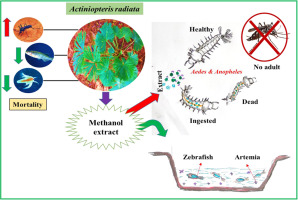Ecotoxicology and Environmental Safety ( IF 6.8 ) Pub Date : 2018-06-06 , DOI: 10.1016/j.ecoenv.2018.05.062 Chinnaperumal Kamaraj , Paramasivam Deepak , Govindasamy Balasubramani , Sengodan Karthi , Dhayalan Arul , Dilipkumar Aiswarya , Vadivel Amutha , Elangovan Vimalkumar , Damodaran Mathivanan , Sundaram Renjitham Suseem , Chanthini Kanagaraj Muthu-Pandian , Sengottayan Senthil-Nathan , Pachiappan Perumal

|
Dengue and malaria are significant mosquito-borne diseases that are rapidly spread worldwide, mainly in temperate countries. Pteridophytes were identified to be a significant source of novel mosquitocidal agents. The present research was to explore the eco-friendly larvicides from methanol extracts of ferns, viz., Actiniopteris radiata, Adiantum caudatum, Cheilanthes swartzii, Hemionitis arifolia and Lycopodium clavatum. The larvicidal potential of the extracts screened using larvae of dengue vector Aedes aegypti (III and IV instar) and malarial vector Anopheles stephensi (III and IV instar), showed 10–100% mortality rates. Biosafety assessment was made on embryos of Danio rerio and Artemia nauplii. The phyto-constituents of the methanol extract of A. radiata leaves were identified through gas chromatography-mass spectrometry (GC-MS). Methanolic leaf extracts of A. radiata, A. caudatum and C. swartzii exhibited larvicidal activity against III and IV instar larvae of Ae. aegypti (LC50: 37.47, 74.51 and 152.38 and 67.58, 95.89 and 271.46 ppm) and An. stephensi (LC50: 70.35, 112.12 and 301.05 and 113.83, 175.30 and 315.19 ppm), respectively. The GC-MS of the methanol extract of A. radiata leaves revealed the presence of 7 phyto-components among which, Carbamic acid, phenyl-, (2-Nitrophenyl) methyl ester (1), Benzoic acid, 3- methylbenzoate (2) and 4-(benzylimino)− 1,4-dihydro-1-(p-toluoylmethyl) pyridine (3) were dominant. Biosafety assessment of methanol extract of A. radiata leaves on embryos of Danio rerio (Zebra fish) and Artemia nauplii (micro crustacean) revealed that there were no destructive or teratogenic effects. To conclude, the larvicidal activity and insignificant toxicity to non-target aquatic organisms of A. radiata leaves makes it a potential and environment safe biocontrol agent against dengue and malarial vectors.
中文翻译:

蕨类提取物对蚊媒和有益水生生物的靶标和非靶标毒性
登革热和疟疾是重要的蚊媒疾病,主要在温带国家迅速传播到世界各地。蕨类植物被认为是新型灭蚊剂的重要来源。本研究旨在探讨蕨类植物的甲醇提取物,环保的杀幼虫剂即,Actiniopteris辐射,鞭叶铁线蕨,Cheilanthes swartzii,Hemionitis arifolia和伸筋草。使用登革热媒介埃及伊蚊(III和IV龄)和疟疾媒介按蚊(Anopheles stephensi)的幼虫筛选提取物的杀幼虫潜力(三龄和四龄)死亡率为10-100%。对Danio rerio和Artemia nauplii的胚胎进行生物安全评价。通过气相色谱-质谱法(GC-MS)鉴定了辐射曲霉叶片甲醇提取物的植物成分。辐射曲霉,尾叶曲霉和Swartzii的甲醇叶提取物对Ae的III和IV龄幼虫表现出杀幼虫活性。aegypti(LC 50:37.47、74.51和152.38和67.58、95.89和271.46 ppm)和An。斯蒂芬斯(LC 50:分别为70.35、112.12和301.05和113.83、175.30和315.19 ppm)。辐射曲霉甲醇提取物的GC-MS分析表明,存在7种植物成分,其中氨基甲酸,苯基-(2-硝基苯基)甲酯(1),苯甲酸,3-甲基苯甲酸酯(2)。和4-(苄基亚氨基)-1,4-二氢-1-(对甲苯甲酰基甲基)吡啶(3)是主要的。甲醇提取物的生物安全评估A.石蒜叶上的胚胎斑马鱼(斑马鱼)和卤虫无节幼体(微型甲壳动物)显示没有破坏性或致畸作用。综上所述,辐射灵芝叶片的杀幼虫活性和对非目标水生生物的微不足道的毒性使其成为对抗登革热和疟疾载体的潜在和环境安全的生物防治剂。



























 京公网安备 11010802027423号
京公网安备 11010802027423号